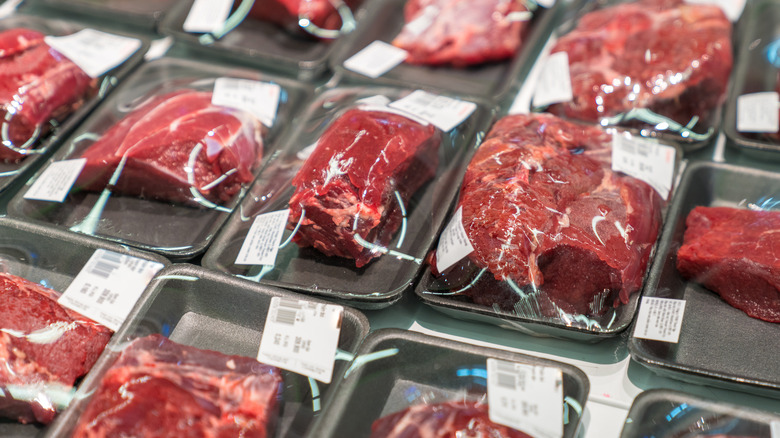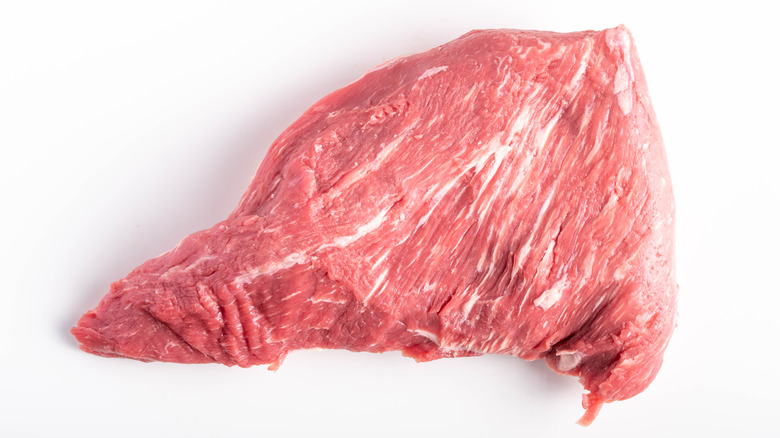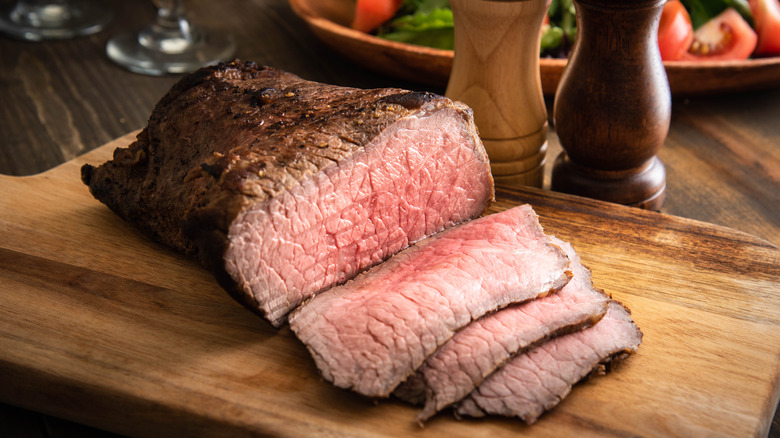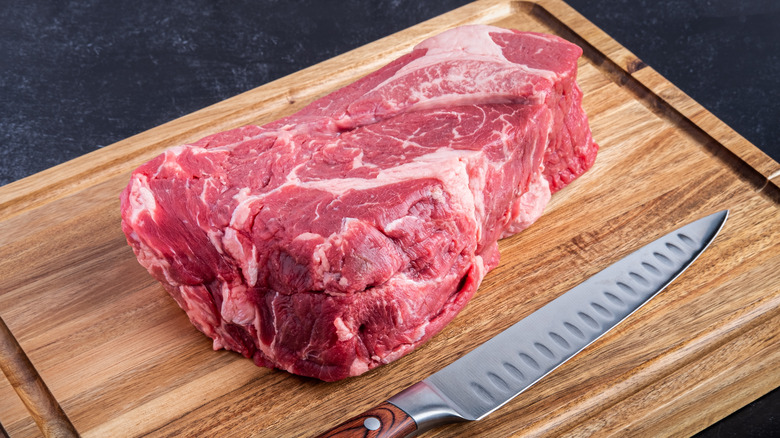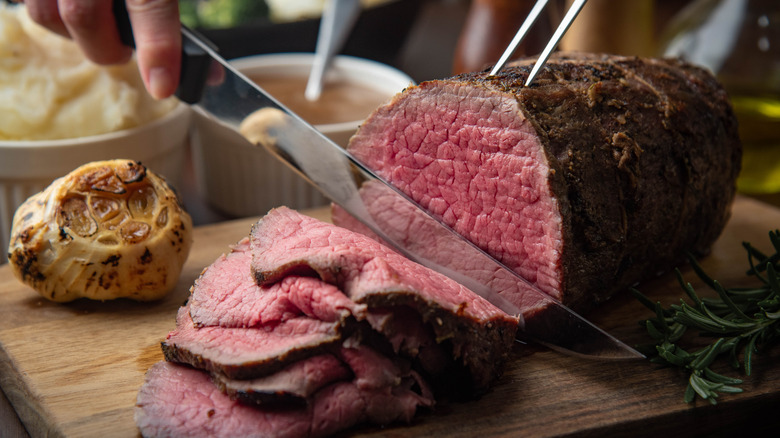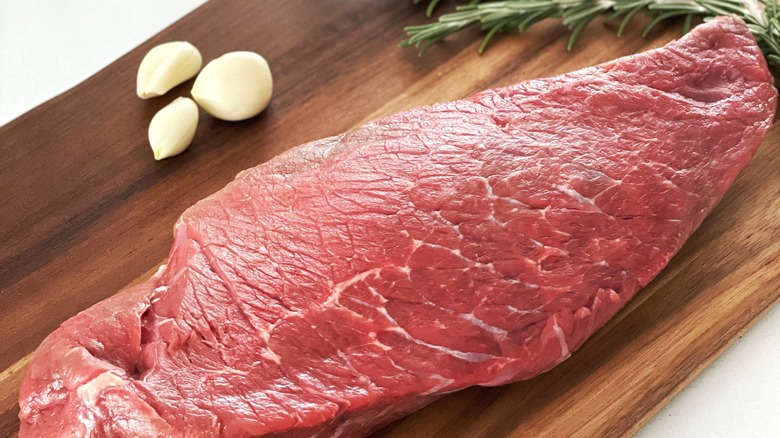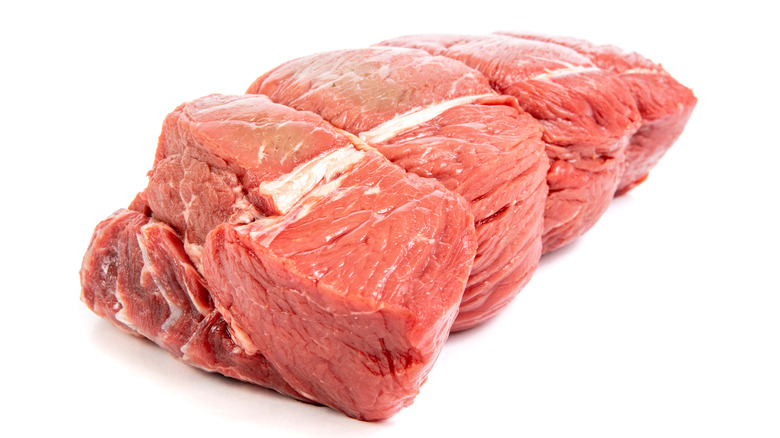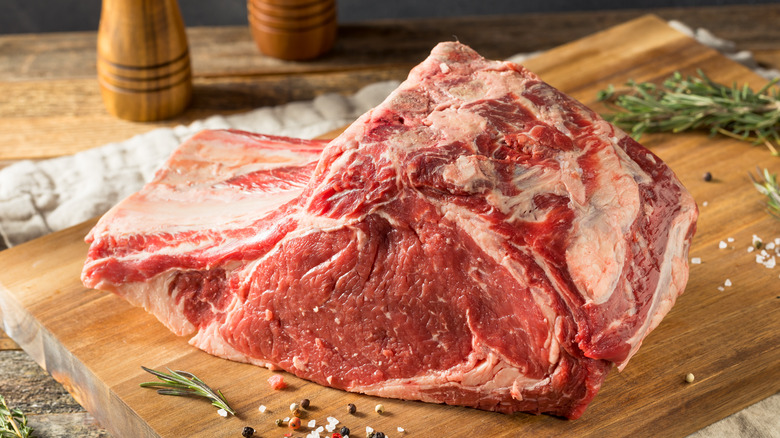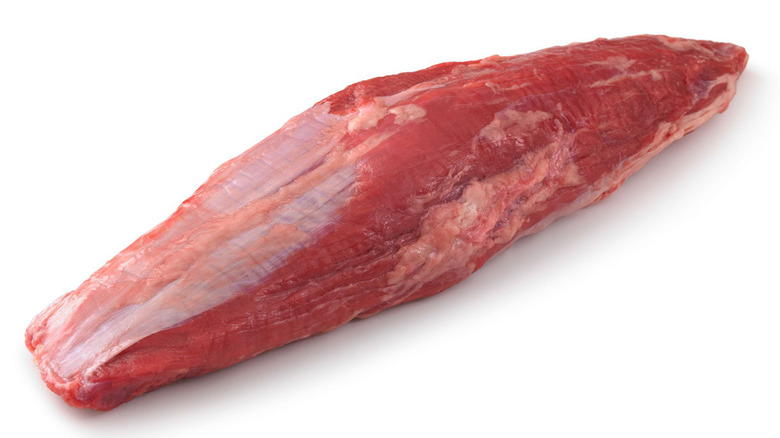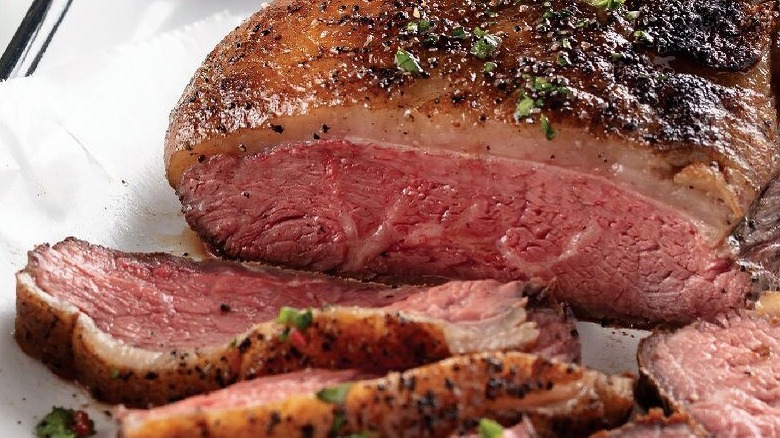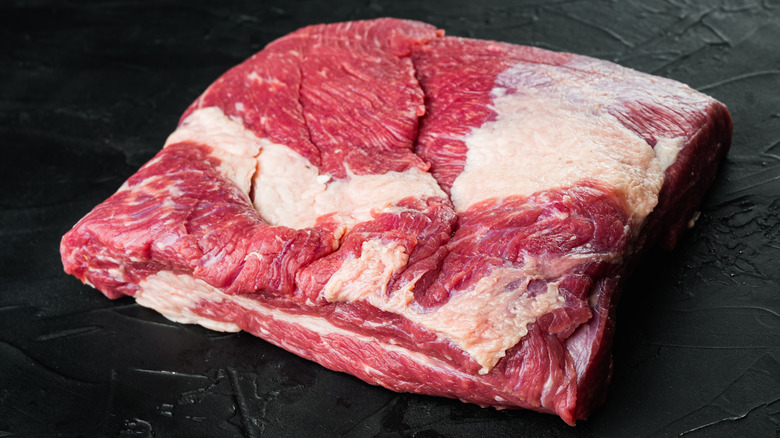The 11 Absolute Best Cuts Of Meat For Roast Beef
Roast beef can be the splurge-worthy centerpiece of a holiday meal or a budget-friendly weeknight dinner. There are almost as many cuts to choose from as there are ways to prepare them. Food Network star and Executive Chef for Omaha Steaks Chef David Rose says roast beef reminds him of family celebrations and the holidays — from smelling a roast in the oven all day to the delicious leftovers.
What cut of meat you should use to make roast beef depends on whether you're looking for a tender, rosy slice of meat or a melt-in-your-mouth bite that's almost falling apart. Cuts vary vastly in price and how they're best prepared, so taking your budget and desired cook time into account is crucial. A less expensive cut that's loaded with connective tissues can become velvety and tender with a low and slow approach, while other cuts need a higher heat and limited cook time for optimal results. Think outside the oven as well — you can even make fantastic roast beef in an air fryer.
From cuts you may never have heard of to the best budget and splurge cuts for making delectable roast beef, learn more about the absolute best cuts of meat for roast beef.
Tri-tip roast
This well-marbled yet lean cut with a robust beefy flavor has been steadily gaining popularity over the years, but you may be more familiar with tri-tip as a steak than a roast. It has a unique triangular shape and is less common on the shelf at your grocery store because there are only two of these cuts per cow.
Chef Rose is a fan of using tri-tip for making roast beef because it has "great beef flavor at a fraction of the price" of many other cuts. He recommends cooking it between rare and medium temperatures, which is about 125 F to 135 F. Anything higher runs the risk of becoming dry or tough. While it can be roasted in an oven, Rose prefers to grill or smoke this cut, and he says it's critical to ensure you slice against the grain, as cutting it incorrectly can lead to toughness.
Bottom round rump
Bottom round rump is a traditional cut for making roast beef that benefits from a low-and-slow style of roasting. This cut hails from the cow's rear leg and, as such, is a leaner piece of meat. You'll see it labeled as London broil when it's cut into steaks, according to Butcher Box.
A four-pound bottom round rump roast will provide between eight and ten servings of meat, and it should be cooked at a lower temperature of 275 F to reach doneness between rare and medium rare or an internal temperature of about 125 to 135 F. Keep in mind the internal temperature of the roast continues to rise during resting, so keeping a close eye on the reading and pulling the meat out before it reaches your desired temperature is key. This is even more critical with a leaner cut like the bottom round rump, which doesn't have intramuscular fat to keep it juicy and tender.
Chuck roast
If you're not a fan of a pink or red center in your roast beef, you may want to give chuck roast a try. While it's not considered traditional roast beef, Chef Rose says it's an inexpensive cut that offers great beef flavor.
Chuck roast contains a large amount of connective tissue like collagen, which takes time to render but creates velvety-soft meat. It goes by several names, including chuck seven-bone pot roast and beef chuck arm. According to the USDA, it is also a fattier cut, with about 16 grams of fat in every three ounces of meat.
Rose recommends braising this cut low and slow as a pot roast or in a crock pot or slow cooker, ensuring you allow the meat enough time to cook gently to prevent it from being dry or tough. Despite being braised in liquid, chuck roast still benefits from a resting period after cooking, just like its leaner, dry-roasted brethren for maximum juiciness.
Eye of round roast
If you're looking for a lean cut for roast beef on the more inexpensive side, the cylindrical eye of round roast is a delicious choice. Like all round cuts, it comes from the round primal, which is cut from the well-exercised rump and rear leg muscles. It's a lean choice, too, since this cut contains just 3.2 grams of fat per three ounces of meat per BeefItsWhatsForDinner.com.
To make up for the intramuscular fat that this potential roast beef cut lacks, a punchy marinade or flavorful rub will help accent the lighter beef flavor characteristic of this cut. Another key to building flavor in an eye of round roast is browning all sides on the stovetop before oven-roasting it slowly at a lower temperature. How it's cut is also important. Slice the eye of round roast thinly against the grain to ensure it isn't chewy and tough.
Top round roast
Top round roast is another lean cut that works well for making tasty, thinly sliced roast beef. In fact, it's the preferred cut for making the meat for a Chicago-style Italian beef sandwich.
This cut of beef comes from the same beef primal section in the rump and rear legs as the bottom round and eye of round cuts. It's called top round because it sits on top of those pieces of meat, according to BeefItsWhatsForDinner.com. It has a similarly low-fat content like those cuts as well, making this a leaner and healthier choice compared to other beef cuts.
Like other round cuts, the top round roast should be cooked low and slow and sliced across the grain. This cut of meat is best cooked to a medium-rare temperature and is regularly used to make the roast beef deli meat you're familiar with, per Masterclass.
Sirloin tip roast
Chef Rose says sirloin tip roast is a great and tasty budget cut with the intensely beefy flavor of a pricier tenderloin roast at a much lower cost. According to BeefItsWhatsForDinner.com, this delicious cut is named after the fact that it is next to the tip of the sirloin. Similar to other lean and inexpensive cuts like the top and bottom round roasts, the sirloin tip roast comes from the round primal.
This inexpensive cut makes great roast beef because it contains a lot of connective tissues like collagen that create a velvety mouthfeel — without the fat. These tough tissues break down with a low and slow cooking method like braising. Rose warns that while this cut has great depth of flavor, it can make for a dry roast beef if you don't allow enough cooking time for the connective tissues to fully break down.
Prime rib roast
Chef Rose's favorite splurge cut for making roast beef is prime rib roast, which he says offers a "jaw-dropping presence" and contains "well-marbled intramuscular fat that renders into the roast for the perfect bite." He points out that trimming the fat is key to this preparation of roast beef. However, the intramuscular fat of this cut also allows prime rib roast to be cooked to a slightly higher internal temperature without sacrificing tenderness — a major win with the higher price tag of this cut.
For the most luscious prime rib roast possible, we recommend letting the meat warm up to closer to room temperature before cooking and seasoning the meat liberally. Rose points out this cut can be too fatty if you don't take the time to trim it properly.
While many roast beef recipes use a low-and-slow method of cooking, you can make a succulent prime rib roast by searing the meat on the stovetop or in an extremely hot oven and then cooking it for 20 minutes per pound at the higher-end temperature of 350 F, aiming to cook the roast to 115 F internally for a rare roast with a cool, red center all the way up to between 120 and 135 F for a medium-rare level of doneness with a pink center and tender bite.
Shoulder petite roast
While you may not have heard of a shoulder petite roast, this is a smaller cut of beef that makes extremely tender and flavorful roast beef. This relatively lean cut of meat, also known as the chuck shoulder tender, shoulder tender, and Teres major, comes from the shoulder area of the animal and has six grams of fat in three ounces of meat, according to BeefItsWhatsForDinner.com. According to Genesee Valley Ranch, it is also known as butcher's steak because it can be difficult to remove properly.
According to Chef Rose, this cut can be succulent and comparable to a filet in flavor and texture but at about half the price. It is often called a "poor man's filet mignon" due to this combination of flavor, tenderness, and budget-friendly pricing. The trick to keeping this cut juicy and tender is avoiding overcooking it, which can cause the meat to be tough and dry, says Rose.
Chateaubriand beef tenderloin roast
A chateaubriand beef tenderloin roast is one of the most expensive choices for making roast beef. Fancy name aside, this is a delicious roast cut from the same piece of meat as filet mignon steaks. While filet mignons are cut from the tapered end of the whole tenderloin, the chateaubriand is cut from the thicker, center portion of the tenderloin, and its even thickness can make it easier to cook this pricier meat evenly.
Pronounced "shah-tow-bree-and," this roast that only makes up about two to three percent of the cow also goes by a few other names you may be more familiar with, like beef tenderloin, tenderloin roast, and filet mignon roast, according to Omaha Steaks.
Chef Rose says this extremely tender cut makes great roast beef because it's moist, has a mild flavor, and is on the lean side. However, he says the lack of intramuscular fat means it will dry out if it's cooked past medium rare.
To make up for the lack of fat, we like to coat a chateaubriand beef tenderloin roast in flavor-enhanced butter — this is a splurge cut, after all. A two-pound roast should be cooked to medium rare (115 F) in a swift 30 to 45 minutes at 300 F, making this one of the faster ways to get your roast beef fix.
Strip loin roast
Chef Rose recommends the strip loin roast for anyone looking for a chateaubriand-like roast beef on a budget. Rose says this cut from the short loin offers a bold loin beef flavor and a good amount of tenderness. While it's not quite as tender as the chateaubriand, he says it's also not as expensive and makes a great budget-friendly substitute.
While the strip loin roast is not typical in most grocery stores, you can ask your butcher to custom cut this well-marbled roast. This cut comes from the short loin and is more often seen cut into thick strip steaks, according to BeefItsWhatsForDinner.com. Strip loin roast is also considered a good substitute for prime rib due to its juicy, tender, and flavorful meat. Like strip steaks, strip loin roasts have a flavorful fat cap on one side that helps keep the meat moist during cooking.
Brisket
Brisket is a flavorful and delicious choice for making roast beef if you won't miss the more traditional rosy center many people associate with the meat. This cut of beef benefits from a slow and low roast or braise. According to Chef Rose, it has a juicy and intense beefy flavor. As brisket comes from a heavily-worked muscle within the chest of the cow, it contains a great deal of connective tissue. Rose explains that this is why it requires enough cooking time to prevent the meat from coming out dry and tough.
A whole brisket consists of a flat cut and a point cut. For oven roasting, we recommend the point cut because it has a fat cap that will protect the meat from drying out during cooking, also making the meat more flavorful. Depending on your butcher, you may want to trim some of this fat further.
